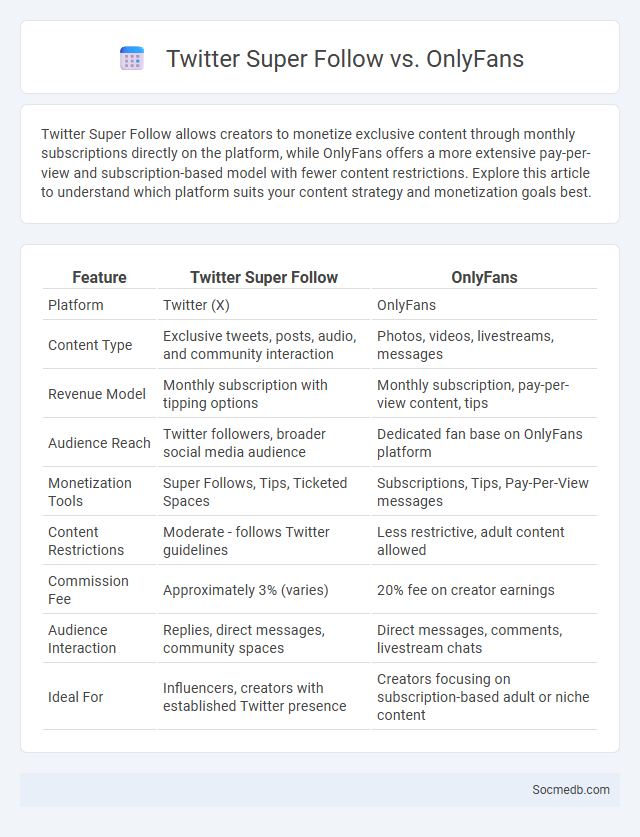
Photo illustration: Twitter Super Follow vs OnlyFans
Twitter Super Follow allows creators to monetize exclusive content through monthly subscriptions directly on the platform, while OnlyFans offers a more extensive pay-per-view and subscription-based model with fewer content restrictions. Explore this article to understand which platform suits your content strategy and monetization goals best.
Table of Comparison
| Feature | Twitter Super Follow | OnlyFans |
|---|---|---|
| Platform | Twitter (X) | OnlyFans |
| Content Type | Exclusive tweets, posts, audio, and community interaction | Photos, videos, livestreams, messages |
| Revenue Model | Monthly subscription with tipping options | Monthly subscription, pay-per-view content, tips |
| Audience Reach | Twitter followers, broader social media audience | Dedicated fan base on OnlyFans platform |
| Monetization Tools | Super Follows, Tips, Ticketed Spaces | Subscriptions, Tips, Pay-Per-View messages |
| Content Restrictions | Moderate - follows Twitter guidelines | Less restrictive, adult content allowed |
| Commission Fee | Approximately 3% (varies) | 20% fee on creator earnings |
| Audience Interaction | Replies, direct messages, community spaces | Direct messages, comments, livestream chats |
| Ideal For | Influencers, creators with established Twitter presence | Creators focusing on subscription-based adult or niche content |
Introduction to Creator Monetization Platforms
Creator monetization platforms empower individuals to generate revenue through their social media content by offering features such as subscriptions, tips, and exclusive content access. Platforms like Patreon, YouTube Memberships, and TikTok Creator Fund provide diverse opportunities to transform creativity into a sustainable income stream. Maximizing your presence on these platforms can significantly enhance your earning potential and audience engagement.
What is Twitter Super Follow?
Twitter Super Follow is a subscription feature that allows users to monetize their content by offering exclusive tweets, behind-the-scenes updates, and personalized interactions to paying followers. Your followers can access this premium content by subscribing for a monthly fee, enabling creators to generate steady income directly through their Twitter presence. This feature enhances community engagement by providing specialized content that is not available to non-subscribers.
What is OnlyFans?
OnlyFans is a subscription-based social media platform where creators monetize exclusive content directly from their followers. Popular among influencers, artists, and adult entertainers, OnlyFans allows you to earn revenue through paid subscriptions, tips, and pay-per-view messages. The platform emphasizes direct engagement and personalized content, making it a unique space for creators to build and sustain a dedicated fanbase.
Key Features Comparison: Super Follow vs. OnlyFans
Super Follow offers exclusive content and community engagement within the Twitter platform, allowing creators to monetize their tweets and interact directly with followers through paid subscriptions. OnlyFans provides a broader content-sharing platform that supports various media types, such as photos, videos, and live streams, with flexible subscription options and pay-per-view features. While Super Follow integrates seamlessly with Twitter's social experience, OnlyFans emphasizes comprehensive content control and monetization tools tailored for creators across multiple niches.
Content Types Allowed: Twitter vs. OnlyFans
Twitter supports a wide range of content types, including text, images, videos, polls, and threads, allowing You to engage with diverse multimedia formats while adhering to community guidelines. OnlyFans primarily focuses on subscription-based content, permitting photos, videos, live streams, and direct messages, often catering to adult content creators with fewer restrictions. Understanding these platforms' specific content allowances helps tailor Your content strategy for maximum engagement and compliance.
Audience & Community Engagement
Social media platforms enhance audience and community engagement by enabling real-time interactions through comments, likes, and shares, fostering stronger brand loyalty and trust. Targeted content strategies based on user demographics and behavior analytics significantly increase engagement rates and community growth. Effective community management, including timely responses and user-generated content promotion, cultivates a vibrant and active online presence.
Pricing and Revenue Models
Social media platforms primarily generate revenue through advertising models, leveraging user data to offer targeted ads that maximize engagement and ROI for businesses. Subscription-based models, including premium features or ad-free experiences, diversify income streams alongside sponsored content and influencer partnerships. Cost structures focus on platform maintenance, user acquisition, and content moderation, balancing operational expenses with scalable revenue opportunities.
Safety and Content Moderation Policies
Social media platforms implement rigorous safety and content moderation policies to protect users from harmful content such as misinformation, hate speech, and cyberbullying. Advanced algorithms combined with human moderators ensure real-time detection and removal of violating posts, fostering a secure online environment. Compliance with regulatory standards like GDPR and COPPA further enhances user protection and data privacy on these platforms.
Platform Growth Opportunities for Creators
Social media platforms like TikTok, Instagram, and YouTube continuously enhance algorithmic features to boost creator visibility and audience engagement. Monetization tools such as brand partnerships, in-app shopping, and fan subscriptions provide diverse revenue streams for creators. Emerging platforms focusing on niche communities offer unique growth opportunities by catering to specific interests and increasing creator-follower interaction.
Choosing the Best Platform for Your Monetization Strategy
Selecting the best social media platform for monetization depends on understanding your target audience's demographics and content preferences, such as Instagram's strength in visual storytelling or TikTok's appeal to younger viewers. Analyze engagement rates, advertising options, and e-commerce integrations available on platforms like YouTube, Facebook, and Pinterest to maximize revenue potential. Tailoring your content strategy to the specific features and algorithm trends of your chosen platform enhances visibility and drives higher conversion rates.
 socmedb.com
socmedb.com